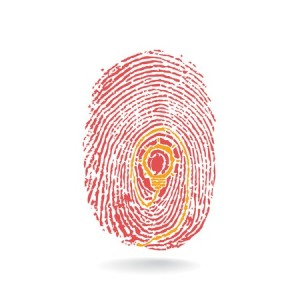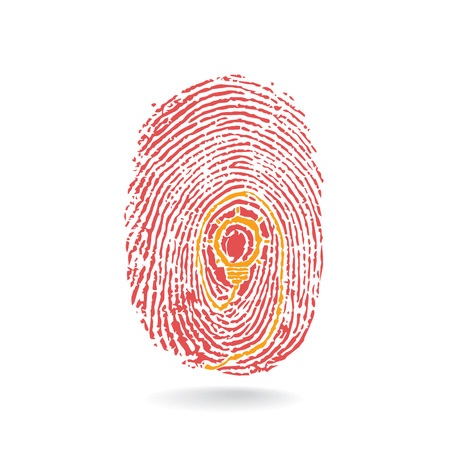
A team of researchers has announced a non-invasive test that can detect cocaine through a fingerprint. Yes, you heard right, a fingerprint. This method can determine whether cocaine has been ingested, rather than just touched. The lead author of the study published in the September 2015 issue of Analyst, Melanie Bailey, said: “The beauty of this method is that, not only is it non-invasive and more hygienic than testing blood or saliva, it can’t be faked. . . . By the very nature of the test, the identity of the subject is captured within the fingerprint ridge detail itself.”
The research team was led by the University of Surrey (UK) and composed of other individuals from the Netherlands Forensic Institute (NL), the National Physical Laboratory (UK), King’s College London (UK) and Sheffield Hallam University (UK). When someone uses cocaine, it is metabolized in the body, producing benzolecgonine (BZE) and methylecgomine (EME). These chemical indicators are in fingerprint residue that can be tested through a procedure called desorption electrospray ionisation (DESI). You can read an abstract of the study here. After registering with RSC Publishing, you can gain free access to the study itself.
The drug testing industry is a multi billion-dollar worldwide industry. The testing process is routinely used by probation services, prisons, law enforcement and the courts. Drug and alcohol counseling centers use them as well. I recently had a counseling session at the outpatient drug treatment I work at that involved reviewing the results of a client’s urine screen. There has been increased interest in workplace drug testing. Identifying ways to drug test motorists are on the horizon. See “Warning All Bakehead Drivers” for information on marijuana breathalyzers.
Drug tests are usually done at this time by taking a blood or urine sample. But blood testing requires trained staff. Urine tests, if supervised, have privacy concerns. Unsupervised urine tests have created an industry of their own consisting of various ways to “beat” the test. Google the term “whizzinator,” if you’re curious about this. Additional limitations for blood and urine samples are they must be treated as a “bio hazards,” which increases the complexity of handling and storing and disposing them.
But a latent fingerprint can be taken quickly and transported easily. What’s more, “The identity of the donor is encapsulated within the fingerprint ridge detail, making the test impossible to falsify.” Two mass spectrometry techniques, desorption electrospray ionisation (DESI) and matrix assisted laser desorption ionization (MALDI) have been demonstrated to provide chemical images of compounds in latent fingerprints.
In the study by Bailey et al., latent fingerprints were obtained from five individuals who were attending a drug and alcohol treatment center. The fingerprints were deposited on clean glass slides before being shipped to two analyzing laboratories. The MALDI test successfully detected BZE. At the time of the MALDI test, researchers were asked specifically to look only for BZE, the primary metabolite. The DESI test found detectable signals for cocaine, BZE and EME in a fingerprint sample. Bailey et al. concluded:
We have demonstrated the use of established and emerging analytical techniques for the analysis of cocaine and its metabolites in natural fingerprints. DESI was carried out under ambient conditions, and atmospheric pressure MALDI systems are also available. This, combined with the ability to analyse the sample in situ and with minimal sample preparation allows for very rapid sample throughput compared with chromatographic methods. The high sensitivity of the methods and selectivity to the analytes described has enabled us to detect metabolites of cocaine drugs from those who use illicit substances. Secondly, although the fingerprints are not spatially uniform, we are optimistic that these approaches can be developed for quantitative analysis of fingerprint residues.
Not surprisingly, there is at least one company in the UK who is already working to produce the world’s first handheld fingerprint drug-testing device. See how the following description fits with the above reported research. “Intelligent Fingerprinting specialises in the development of non-invasive diagnostic screening technology for fast and convenient point-of-care testing using fingerprints.” They expect to go into production with their hand-held devices sometime in 2015. The company was founded by David Russell in 2007, the same year he published an article describing a new method of fingerprinting: “Intelligent” Fingerprinting: Simultaneous Identification of Drug Metabolites and Individuals by Using Antibody-Functionalized Nanoparticles.” Russell pioneered nanoparticle technology research at the University of East Anglia.He is currently the company’s Chief Scientific Officer.
Non-invasive and easy-to-use, Intelligent Fingerprinting’s drug screening device eliminates the need for the specialist collection arrangements and biohazard disposal facilities associated with conventional drug testing methods involving blood, urine or saliva samples. The new technology is expected to revolutionise drug testing globally in many sectors including criminal justice, drug rehabilitation and the workplace.
Their diagnostic technique screens for drug metabolites found in “the minute traces of sweat” that can be found in a fingerprint. Currently, from a single fingerprint, one test screens for: amphetamines, benzodiazepines, cannabis, cocaine and opiates. Since the technique detects drug metabolites rather than the drug itself, “a positive result indicates that the person being screened has taken the drug and not simply touched a contaminated surface.” An image of the person’s fingerprint is taken as part of the drug screening technique. If needed, it can be used to confirm the identity of the person who was tested, thus minimizing the risk of cheating or the misidentification of samples.
The device’s diagnostic technique may be used to identify other types of metabolites and chemicals found in fingerprint sweat. Research is ongoing into a variety of new applications for their technology.
There has been some strong US investment interest in the company. In 2012 Intelligent Fingerprinting received £2 million in US backing. And in January of 2014, a consortium of private US investors put an additional £750,000 into the company. The additional funds allowed the company to accelerate the introduction of the device to the global market. “The ongoing support from investors validates our assertion that we have a technology with massive potential.”
If the technology can be demonstrated to do reliable, reasonably priced testing, this would be an effective tool in addiction counseling. The immediacy of the test results and its non-invasive nature are strong selling points. It certainly could be helpful to probation officers and the court system. And it definitely has a place for on-the-job testing. But there are some law enforcement situations I’m not sure it would benefit.
Unless there is some way to assess how much time has passed since a drug was used, the test would have limited use for testing drugged drivers. For example, knowing someone has used marijuana recently is different than knowing they used it in the past 2 hours. It may have a place as an initial field test in DUI traffic stops. But would it be used on drivers who had been stopped for just any traffic violation? If someone tested positive, say for cocaine, would that be enough for an arrest?





